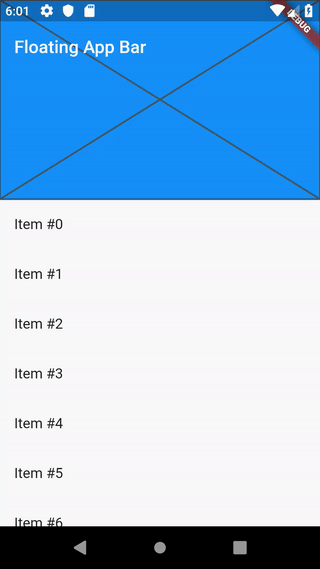Place a floating app bar above a list
To make it easier for users to view a list of items, you may want to hide the app bar as the user scrolls down the list. This is especially true if your app displays a “tall” app bar that occupies a lot of vertical space.
Traditionally, you create an app bar by providing an appBar property to the Scaffold Widget. This creates a fixed app bar that always remains above the body of the Scaffold.
Moving the app bar from a Scaffold Widget into a CustomScrollView allows you to create an app bar that scrolls offscreen as you scroll through a list of items contained inside the CustomScrollView.
This recipe demonstrates how to use a CustomScrollView to display a list of items with an app bar on top that scrolls offscreen as the user scrolls down the list.
Directions
- Create a
CustomScrollView - Use
SliverAppBarto add a floating app bar - Add a list of items using a
SliverList
1. Create a CustomScrollView
In order to create a floating app bar, you need to place the app bar inside a CustomScrollView that also contains the list of items. This synchronizes the scroll position of the app bar and the list of items. You may think of the CustomScrollView Widget as a ListView that allows you to mix and match different types of scrollable lists and widgets together!
The scrollable lists and widgets that can be provided to the the CustomScrollView are known as slivers. There are several types of Slivers, such as a SliverList, SliverGridList, and SliverAppBar! In fact, the ListView and GridView Widgets use the SliverList and SliverGrid widgets under the hood!
For this example, create a CustomScrollView that contains a SliverAppBar and a SliverList. In addition, you need to remove any app bars you may be providing to the Scaffold Widget!
Scaffold(
// No appBar property provided, only the body!
body: CustomScrollView(
// Add the app bar and list of items as slivers in the next steps
slivers: <Widget>[]
),
);
2. Use SliverAppBar to add a floating app bar
Next, add an app bar to the CustomScrollView. Flutter provides the SliverAppBar Widget out of the box. Much like the normal AppBar widget, you can use the SliverAppBar to display a title, tabs, images and more.
However, the SliverAppBar also gives you the ability to create a “floating” app bar that scrolls offscreen as the user scrolls down the list. Furthermore, you can configure the SliverAppBar to shrink and expand as the user scrolls.
To achieve this effect:
- Start with an app bar that displays only a title
- Set the
floatingproperty totrue. This allows users to quickly reveal the app bar when they being scrolling up the list. - Add a
flexibleSpacewidget that will fill the availableexpandedHeight.
CustomScrollView(
slivers: <Widget>[
SliverAppBar(
title: Text('Floating app bar'),
// Allows the user to reveal the app bar if they begin scrolling back
// up the list of items
floating: true,
// Display a placeholder Widget to visualize the shrinking size
flexibleSpace: Placeholder(),
// Make the initial height of the SliverAppBar larger than normal
expandedHeight: 200,
),
],
);
3. Add a list of items using a SliverList
Now that you have the app bar in place, add a list of items to the CustomScrollView. You have two options: a SliverList or a SliverGrid. If you need to display a list of items one after the other, use the SliverList Widget. If you need to display a grid list, use the SliverGrid Widget.
The SliverList and SliverGrid Widgets take one required parameter: a SliverChildDelegate. While this sounds fancy, the delegate is simply used to provide a list Widgets to SliverList or SliverGrid. For example, the SliverChildBuilderDelegate allows you to create a list of items that are built lazily as you scroll, just like the the ListView.builder Widget.
// Create a SliverList
SliverList(
// That uses a delegate to build items as they're scrolled on screen.
delegate: SliverChildBuilderDelegate(
// The builder function returns a ListTile with a title that
// displays the index of the current item
(context, index) => ListTile(title: Text('Item #$index')),
// Builds 1000 ListTiles
childCount: 1000,
),
)
Complete example
import 'package:flutter/foundation.dart';
import 'package:flutter/material.dart';
void main() => runApp(MyApp());
class MyApp extends StatelessWidget {
MyApp({Key key}) : super(key: key);
@override
Widget build(BuildContext context) {
final title = 'Floating App Bar';
return MaterialApp(
title: title,
home: Scaffold(
// No appbar provided to the Scaffold, only a body with a
// CustomScrollView
body: CustomScrollView(
slivers: <Widget>[
// Add the app bar to the CustomScrollView
SliverAppBar(
// Provide a standard title
title: Text(title),
// Allows the user to reveal the app bar if they begin scrolling
// back up the list of items
floating: true,
// Display a placeholder Widget to visualize the shrinking size
flexibleSpace: Placeholder(),
// Make the initial height of the SliverAppBar larger than normal
expandedHeight: 200,
),
// Next, create a SliverList
SliverList(
// Use a delegate to build items as they're scrolled on screen.
delegate: SliverChildBuilderDelegate(
// The builder function returns a ListTile with a title that
// displays the index of the current item
(context, index) => ListTile(title: Text('Item #$index')),
// Builds 1000 ListTiles
childCount: 1000,
),
),
],
),
),
);
}
}


